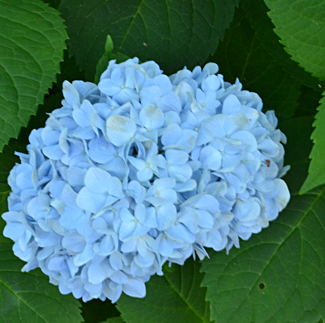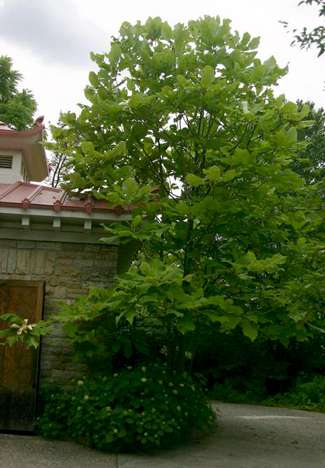
by Connie Oswald Stofko
There are hydrangea plants that have blue flowers only when planted in acidic soil. In neutral soil, the flowers are pink. That means that if you want blue flowers and your soil is neutral, you have to add a lot of acid to your soil to get the flower color you want.
You may be making more work for yourself than you want.
“Ornamental plants should only bring you joy,” said Andrew Keys, writer, plantsman and lifelong gardener.
It’s not as if we are growing these plant for food or for materials to build our homes, Keys said in a phone interview. Gardening should be fun, and if the amount of work you are putting into it is taking the fun out it, you can make some changes.
In the case of the hydrangea, instead of trying to make the soil in your garden bed acidic, it might be easier to grow that blue hydrangea in a container.
Or simply choose a different plant.
Key will give the keynote address, “Why Grow This When We Can Grow That,” during PLANT WNY’s daylong Education Conference on Friday, Feb. 3 at Salvatore’s Italian Gardens, 6461 Transit Rd., Depew. He will also speak on “Uncommon Plants in the Northeast.”
He will sign his books, Why Grow That When You Can Grow This?: 255 Extraordinary Alternatives to Everyday Problem Plants and Growing the Northeast Garden, which will be available that day by cash or check only.
The Education Conference is open to Master Gardeners and advanced gardeners as well as to green industry professionals. It isn’t recommended for beginning gardeners, but there will be plenty of seminars for beginners at PLANT WNY’s Plantasia, Thursday through Sunday, March 23 to 26. And Keys shares more tips for everyone later in this article.
The cost of Education Day is $85 per person and includes lunch and the trade show. Four or more people from the same company or organization can deduct $10 per person. If registering after Jan. 30, add $20 per person. Walk-ins are welcome.
See the list of talks and other details about the Education Conference here. (Note that CNLP Day and Horticulture 101 Day on Thursday mentioned in the brochure are open only to industry professionals.)
For more more information, call Joyce at 741-8047.
The basics: soil and plant choice

“I have a ‘don’t-fight-the-site’ philosophy,” said Andrew Keys. “Pick the right plant for the right site.”
Keys has been living north of Boston, Massachusetts, since 2001, but he grew up in Mississippi, near New Orleans. Some of the things he did gardening in the South were different because of the weather, “but there were some things I did growing up that were just wrong,” he said.
He used to use a lot of chemical fertilizer to make his plants grow, but now that he knows more about environmental issues and the soil, he doesn’t use fertilizer at all.
“The two biggest things are soil and working with your site,” he said. “Feed the soil and you feed your garden. Use lots and lots of compost. It’s easy to get and you can even make it yourself.”
He also suggested learning the pH of your soil and what your soil might be lacking.
Tips for choosing alternative plants
“The concept of my book is that it’s easy to choose alternatives to plants that aren’t problematic,” Keys said.
One tip he has for us Western New York gardeners is to look at the tag on a “regulated plant.” New York State, unlike many other states, has not one but two designations for invasive species of plants. “Prohibited plants” can’t be sold by garden centers at all. “Regulated plants” can be sold by garden centers and used in gardens, but can’t be introduced into the wild. See more details here.
When regulated plants are sold, they have to carry a tag that tells the customer that it is an invasive species. Not only that, the tag has to list three alternative plants– noninvasive species that you might plant instead.
If you looked at a burning bush, which is a regulated plant, the tag might suggest that you could use Itea or Virginia sweetspire, which has fragrant flowers and leaves that turn varying shades of red, orange and gold in autumn; fothergilla, which has attractive bottlebrush-like flowers and excellent fall color; or red chokeberry or black chokeberry, which have multi-season ornamental interest. The fruit of the black chokeberry, though very tart, can be used in jellies.
Keys said that he likes tropical plants, but you can’t plant them in gardens in Western New York or anywhere in the northeast. As an alternative, he likes to choose plants with bold foliage that work in our gardening zones.
A couple good choices are magnolia trees with big leaves: Magnolia macrophylla, commonly called big leaf magnolia, or Magnolia tripetala, commonly called umbrella magnolia. The big leaves give the trees a tropical feel. They’re pretty when they bloom, but you would grow these trees for the leaves rather than the flowers. The trees are small, so they fit well into lots of landscapes. They’re both native to New York State, he added.

You don’t find them for sale at nurseries much and professionals don’t use them much, Keys said, but you can get them mail order. These magnolias grow fast, which is good because the plants you get through mail order tend to be smaller specimens. The clients of landscapers and home gardeners both like things that grow quickly.
You can see big leaf magnolias along the High Line in Manhattan, a 1.45-mile-long park built on an elevated section of a New York Central Railroad spur that is no longer used.
“They’re hard to miss,” he said.
When it comes to plants, people always think about color first, but Keys recommends paying attention to texture. It’s the design element that people discount the most, but can be key.
“If you think, ‘I don’t know why I love that plant,’ texture is often the ‘why,'” Keys said.
Look at leaf size, shape and sheen as well. When you do, “a whole world of design opens up to you,” he said.
Keys is working toward his master’s degree in art, mainly sculpture and photography, at San Francisco Art Institute. He also has a degree in journalism and at one time had a small landscaping company.



I had no trouble growing these mop head florist hydrangea in my garden. They did well every year and did not wilt in summer. While not really great for our area, the bed was well protected and formed a microclimate. It remained moist in summer and was warmed in winter by all the stone paving and gravel drainage.